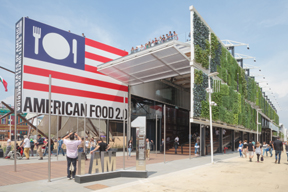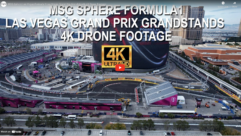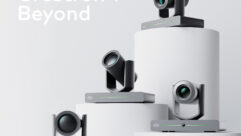
SVC Podcast – Show Notes – Show 138-1:
In this edition of the SVC Podcast, SVC Contributing Editor Bennett Liles talks with Steve Haas, President of SH Acoustics, about a very challenging sound system installation for the U.S. pavilion at Expo Milano, the World’s Fair happening in Milan, Italy. Steve outlines the acoustic difficulties and construction schedules that made things interesting on the installation and testing. He also discusses the SymNet DSPs that were used to get the sound under control, particularly in limiting sound leakage between areas inside the pavilion.
Links of interest:
- SH Acoustics – Acoustic Consulting and Installation
- Expo Milano, the Universal Exhibition in Milan, Italy
- Thinc Design, the exhibit design firm that brought in SH Acoustics
Download Podcast Here:
https://s3.amazonaws.com/nb-svc/public/public/138-1Expo_Milano_SH_Acoust…
From Sound & Video Contractor Magazine, this is the SVC Podcast with Steve Haas of SH Acoustics. Show notes for the podcast are available on the web site of Sound & Video Contractor Magazine at svconline.com.
The first World’s Fair since 2012 is underway in Milan, Italy and the American pavilion presented a very challenging sound environment. They called in SH Acoustics to make the sound system worked, and company president Steve Haas is here to let us know how it all came out using SymNet DSPs. That’s coming right up on the SVC Podcast.
Steve it’s great to have you with us on the SVC Podcast from SH Acoustics in Milford, Connecticut. We have a project to talk about at the World’s Fair, Expo Milano, going on right now and a tough sound system installation in the U.S. Pavilion but before we get into that how about telling us about SH Acoustics?
Sure, Bennett, and thank you for the opportunity to be part of this. We have been primarily known for two different market sectors, and that is museums and exhibit-related work as well as high-end residential, and both of them we pursue very actively and work on projects all around the world. We certainly do plenty of other types of projects from corporate to high-end other types of high-rise buildings and such, but we do focus on those two specialties. [Timestamp: 1:40]
And you had a very big job with the World’s Fair, Expo Milano. I’ve seen some of the pictures of the U.S. Pavilion and it from the outside I can see some of the challenges you may have had but what really made the sound system installation there such a big job?
Well, it was both the audio and the acoustics that were very challenging mainly because, as some people might know, these pavilions are meant to be temporary structures. Some of them remain, but some of them actually get torn down at these World’s Fairs. And so the mentality from everybody – from the designers, the architects, the exhibit designers, the contractors – is not necessarily to look at this as a hundred-year building and so we had to be very judicious about working in that type of capacity and understanding that everything that we would normally expect to see happen in the very solid, long-term building may not get done in a temporary structure like this. Even though they’ve spent millions and millions of dollars on it, it’s still considered a six-month project as far as how long the expo lasts. Having said that, though, the amount of capacity that they anticipated and are now realizing are in the millions. Within that six months I think they set the record already for I think $1.2 million since it opened in May, which is not bad for a little structure in three months or so. So we had to look at all aspects of the acoustics and the audio from the perspective that we normally do in museums and museum exhibits in that there are a lot of things happening all on top of each other and we have to be able to control it within the pavilion, but also realize that there are some major events and activities surrounding the pavilion from other pavilions, but also activities just generally on the fairgrounds that might bleed into the open architecture, and also let’s say the not-so-solid construction that the pavilion was created from, at least acoustically solid. [Timestamp: 4:03]
So how did your guys get involved in this project originally? You obviously have considerable experience in this sort of thing, but how did your paths cross with this project?
Sure. So we were brought in by the project exhibit designer, Thinc Design, who is known for such prestigious projects like the 9/11 museum and numerous others that we have worked with them on. And they knew that they needed an expert in sound control, mainly because they did not have the highest confidence that these local contractors and fabricators and such were going to address these issues on their own, even though they did end up hiring a very good-quality integrator out of Europe to install the audio and video systems. They still needed somebody to be able to design something that would be appropriate enough and calibrate it in the end and that’s how we got involved. [Timestamp: 5:03]
Well with something as big as this, I guess it’s unrealistic to expect that nothing is going to get changed along the way while you’re working on it. So did the system requirements change as the construction went along?
The expo opened May 1. The systems were still changing the last week of April if that gives you any indication. That was one of the biggest challenges is that the building itself ended up being so far behind schedule that we had to make a lot of on-the-spot changes, too, based on what the integrators could achieve since the contractors were still literally building the building on top of the integrators. And so there are certain pieces of equipment, there are certain functions that could not happen because the power wasn’t even on for a lot of the time that we were out there. So there were – it was definitely a fun, exciting, but stressful challenge. [Timestamp: 6:04]
Well, no power. That would make testing rather difficult. So how did you choose the SymNet Radius DSPs? Your guys were not exactly strangers to SymNet products were they?
No, not at all. We’ve become very fond of Symetrix and all of their products through our work in museums, but even in the high-end residential applications. We have been using them extensively throughout some of the most elaborate private theaters that we work on in homes and the reliability and the functionality, the ease of programming were the key factors that keep us coming back to Symetrix and their different platforms. The Radius platform is just really appropriate for this particular application. As a matter of fact, the integrator had suggested another brand of DSP that we weren’t completely familiar with. And we knew that we were going to have such limited time under very strained working conditions and the last think we wanted to deal with was a system that we had no idea about reliability and having to learn a completely different program, which we certainly do, but it’s just not in that condition did we want to risk this. So we were able to convince the client and the design team that this was the best solution for the scale and this nature of project. [Timestamp: 7:34]
There were a lot of destinations for the audio. I noticed one of your favorite brands of ceiling speakers are from Innovox Audio. What makes those special? Were they custom designed?
Innovox is an interesting company because they do a lot of different types of standard products, but they also be able to customize different products for us on a flash – meaning very quickly. And although we didn’t necessarily need the customization on this particular project, it’s good to know that we can get the speakers from them of varying sorts. And one of the key issues here that led to the selection of brands was simply the fact that we had so many different programs very close to each other, on top of each other. Some of these programs, such as in the big immersive foodscapes had seven different theatrical multimedia presentations all playing extremely loud with no solid barriers between them. We had to do everything with acoustic treatment and audio control and so we needed to make sure that the dispersion of the speakers that we chose met a very specific controlled pattern without giving up quality. [Timestamp: 8:48]
I guess that your experience with museums really came into play for minimizing audio leakage from one area to another?
Absolutely.
How are you using the DSPs to minimize the audio leakage between areas?
It comes into the final calibration. Certainly any DSP, any quality DSP can use the necessary equalization and delay and balancing to be able to get the proper control and the proper quality of sound, but at the same time we definitely work very hard on that calibration because we can have the design good and then we get to the field and a million things changed. For instance, we had ideally placed a series of ceiling speakers to combine with front speakers and give you a more immersive feeling, delay from the proximity speakers, and yet when we got to the site and the lighting designer and lighting team had put up all of their light fixtures and basically left us with speaker positions that just couldn’t work any longer. So we had to be able to look at alternative locations that would fall not just within the light fixture areas themselves or outside of the light fixture areas, but also out of the projection of both the light cones that were projecting on the screens as well as the video projector cones that were projecting on the screens. So again, a lot happening in a very small space, which is not uncommon, but it resulted in the need to even rely on DSP calibration even further to set very precise time delays and get everything feeling and sounding very good. [Timestamp: 10:33]
Yeah, I was going to ask you about coordination between the various trades on the job but you hit that right on the head. Having so many people working on so many different things under deadline, you can have a lot of things all stacked up waiting on one little detail. I guess you also have to be kind of a diplomat working with all of these other teams.
Exactly. I mean I’m sure your listeners are no strangers to having to work on top of each other in the final hours of a project, but in this case adding the cultural differences, the language barriers, no matter what people tell you, most Italians do not speak English – at least not the workers. So it was very difficult to communicate at times and ask for the things that we needed to from the local contractors to be able to get the project done, especially since there were at least two or three other entities there – meaning the lighting folks, the exhibit folks, the others all trained to get their part of the puzzle in place and on top of each other. And then, as I mentioned earlier, one of the biggest coordination challenges is just the outside noise influences that affected our calibration work. Normally when we’re in a big museum we can just say okay, we’ll work at 2:00 a.m. and pretty much be sure that we have the place to ourselves without much happening. Well, at 2:00 a.m. on the expo site there were jackhammers and other major machineries going on all night, all throughout the night, so we did not have any complete points where it was silent and that we could really hear to a fine degree. But we did the best we could. [Timestamp: 12:18]
Well, it was great hearing about this and we’ll get into some of the details in Part 2 on the Dante media network and the Yamaha and Stewart Audio amplifiers. It’s Steve Haas, President of SH Acoustics and the U.S. Pavilion at Expo Milano. Thanks for being with us, Steve.
You’re very welcome.
Thank you for being here with us for the SVC Podcast with Steve Haas. Show notes are available on the website of Sound & Video Contractor Magazine at svconline.com. Be back with us for Part 2 when Steve will get into more details on the Expo Milano project including amplifier placement and the SymNet Composer software. That’s on the next SVC Podcast.










